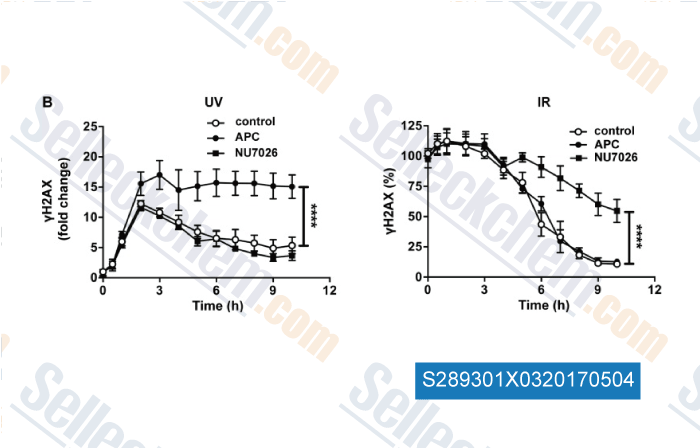|
Toll Free: (877) 796-6397 -- USA and Canada only -- |
Fax: +1-832-582-8590 Orders: +1-832-582-8158 |
Tech Support: +1-832-582-8158 Ext:3 Please provide your Order Number in the email. |
Technical Data
| Formula | C17H15NO3 |
|||
| Molecular Weight | 281.31 | CAS No. | 154447-35-5 | |
| Solubility (25°C)* | In vitro | DMSO | 1 mg/mL (3.55 mM) | |
| Water | Insoluble | |||
| Ethanol | Insoluble | |||
|
* <1 mg/ml means slightly soluble or insoluble. * Please note that Selleck tests the solubility of all compounds in-house, and the actual solubility may differ slightly from published values. This is normal and is due to slight batch-to-batch variations. * Room temperature shipping (Stability testing shows this product can be shipped without any cooling measures.) |
||||
Preparing Stock Solutions
Biological Activity
| Description | NU7026 (LY293646) is a potent DNA-PK inhibitor with IC50 of 0.23 μM in cell-free assays, 60-fold selective for DNA-PK than PI3K and inactive against both ATM and ATR. NU7026 enhances G2/M cell arrest and apoptosis. | ||||
|---|---|---|---|---|---|
| Targets |
|
||||
| In vitro | NU7026 potentiates ionizing radiation induced cytotoxicity in a concentration-dependent manner in V3YAC and PARP-1+/+ cells. NU7026 completely abolishes potentially lethal damage recovery in growth-arrested cells. NU7026 inhibits DNA DSB repair by 56% in the V3YAC cell line. [1] NU7026 (10 μM) potentiates the growth inhibitory effects of doxorubicin, mAMSA with PF50 values ranging from approximately 19 for mAMSA to approximately 2 in K562 cells. NU7026 (10 μM) also potentiates the growth inhibitory effect in this leukemia cell line with a PF50 value of 10.53. NU7026 (10 μM) enhances the -induced cell cycle G2 blockade in K562 cells. NU7026 potentiates topo II poisons involves inhibition of nonhomologous end joining and a G2/M checkpoint arrest. [2] NU7026 (10 μM) exposure of 4 h in combination with 3 Gy radiation is required for a significant radiosensitisation effect in CH1 human ovarian cancer cells. [3] NU7026 (< 10 μM) has synergistic cytotoxic activity at nontoxic doses of NU7026 in a CLL cell line (I83) and in primary CLL-lymphocytes. NU7026 (10 μM) increases -induced G(2)/M arrest in I83 cells. NU7026 (10 μM) enhances -induced γH2AX throughout the cell cycle in the I83 cell line. NU7026 (10 μM) Increases -Induced apoptosis in the I83 cell line. [4] NU7026 (55 μM) results in a dramatic induction of telomere fusion in p53 null MEFs and significantly fewer telomere fusions in p53 and ligase IV double null MEFs. [5] |
||||
| In vivo | NU7026 (20mg/kg, i.v.) undergoes rapid plasma clearance (0.108/hour) in mice and this is largely attributed to extensive metabolism. Bioavailability following interperitoneal (i.p.) and p.o. administration of NU7026 at dose of 20 mg/kg is 20 and 15%, respectively. [3] |
Protocol (from reference)
| Kinase Assay: |
|
|---|---|
| Cell Assay: |
|
| Animal Study: |
|
References
Customer Product Validation

-
Data from [Nucleic Acids Res, 2013, 41(15), 7378-86]

-
Data from [Data independently produced by , , Clin Cancer Res, 2014, 20(13): 3496-50]

-
Data from [Data independently produced by , , Nucleic Acids Res, 2016, 44(21):10259-10276]

-
Data from [Data independently produced by , , Oncotarget, 2016, 7(25):38367-38379]
Selleck's NU7026 has been cited by 65 publications
| Topoisomerase I is an evolutionarily conserved key regulator for satellite DNA transcription [ Nat Commun, 2024, 15(1):5151] | PubMed: 38886382 |
| LC3B drives transcription-associated homologous recombination via direct interaction with R-loops [ Nucleic Acids Res, 2024, gkae156] | PubMed: 38412240 |
| Generation and characterization of six human induced pluripotent stem cell lines (hiPSCs) from three individuals with SSADH Deficiency and CRISPR-corrected isogenic controls [ Stem Cell Res, 2024, 77:103424] | PubMed: 38677032 |
| Topoisomerase I is an Evolutionarily Conserved Key Regulator for Satellite DNA Transcription [ bioRxiv, 2024, 2024.05.03.592391] | PubMed: 38746280 |
| Blocking Genomic Instability Prevents Acquired Resistance to MAPK Inhibitor Therapy in Melanoma [ Cancer Discov, 2023, 13(4):880-909] | PubMed: 36700848 |
| Blocking Genomic Instability Prevents Acquired Resistance to MAPK Inhibitor Therapy in Melanoma [ Cancer Discov, 2023, 13(4):880-909] | PubMed: 36700848 |
| ABL1 kinase as a tumor suppressor in AML1-ETO and NUP98-PMX1 leukemias [ Blood Cancer J, 2023, 13(1):42] | PubMed: 36959186 |
| A function for ataxia telangiectasia and Rad3-related (ATR-kinase in cytokinetic abscission. [ iScience, 2023, 25(7)] | PubMed: None |
| The fatty liver disease-causing protein PNPLA3-I148M alters lipid droplet-Golgi dynamics [ bioRxiv, 2023, 2023.10.13.562302] | PubMed: 37873239 |
| DNA-PK promotes activation of the survival kinase AKT in response to DNA damage through an mTORC2-ECT2 pathway [ Sci Signal, 2022, 15(715):eabh2290] | PubMed: 34982576 |
RETURN POLICY
Selleck Chemical’s Unconditional Return Policy ensures a smooth online shopping experience for our customers. If you are in any way unsatisfied with your purchase, you may return any item(s) within 7 days of receiving it. In the event of product quality issues, either protocol related or product related problems, you may return any item(s) within 365 days from the original purchase date. Please follow the instructions below when returning products.
SHIPPING AND STORAGE
Selleck products are transported at room temperature. If you receive the product at room temperature, please rest assured, the Selleck Quality Inspection Department has conducted experiments to verify that the normal temperature placement of one month will not affect the biological activity of powder products. After collecting, please store the product according to the requirements described in the datasheet. Most Selleck products are stable under the recommended conditions.
NOT FOR HUMAN, VETERINARY DIAGNOSTIC OR THERAPEUTIC USE.
